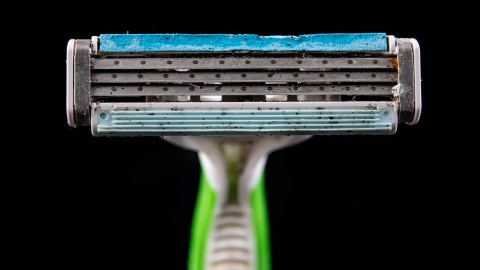Why your hair dulls the sharpest razor blades

Piotr Wytrazek/Shutterstock
- Steel is fifty times harder than hair, yet shaving razors dull in a hurry.
- A new study finds much of this is caused by hair cracking razors at points of imperfection.
- The findings may lead to new ways of making razors that last longer.
Everybody who shaves regularly knows that most razors only last a few shaves. Given that hair is not nearly as hard as steel, this tendency seems odd. Why should soft hair degrade steel? Until now, the assumption had always been that each shave dulled the blade to the point of it losing its sharp edge.
Now, a curious new study out of MIT finds that this isn’t what happens at all. Instead, your hair can crack stainless steel under the right circumstances.

An extremely magnified image of a razor blade cutting hair. G. Roscioli
Lead author Gianluca Roscioli grew his facial hair out for three days before shaving. He then brought his razors into the lab to examine them under an electron microscope. While the team expected to see even dulling on the blade edge, they instead noticed strange C-shaped chips missing. Intrigued, they attached a camera to the microscope so they could record the blade cutting the hair. At the same time, they investigated the properties of the razors at the microscopic level.
This apparatus revealed that, when the razor blade hit the hairs at non-perpendicular angles, small cracks formed. These tended to develop in boundary areas between where the steel was harder and where it was softer due to differences in the properties at each location caused by the manufacturing process. Over time, these cracks grew into chips. While these chips are too small to see with the naked eye, they were large enough to reduce the blade’s effectiveness.
Roscioli told NPR, “The size of the chips are about 1/10 of the diameter of a human hair.”
The chips can be caused by hair of any thickness and appear to be unavoidable in blades with standard imperfections.
The finding surprised other scientists, who also quickly accepted the explanation. Professor Suveen Mathaudhu of UC Riverside explained to NPR that he had expected a larger role in the dulling process to be played by corrosion but that the findings made a great deal of sense. Other scientists expressed how impressed they were by the quality of the images and the difficulty of the study.
Shirley Polykoff, Hair Care Pioneer
The study determined that part of the reason for this chipping is the imperfections in the steel used to make the blades, specifically the lack of uniformity in the composition of the steel at the microscopic level. At least partly, these imperfections are due to the nature of the production process and can be reduced through alternative methods. This study’s research team is also working on a new material with more structural uniformity as a possible solution.
These findings may one day lead to longer-lasting razor blades. Given that Americans throw out two billion blades each year, such a discovery’s environmental impact would be tremendous.





